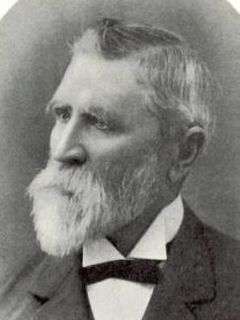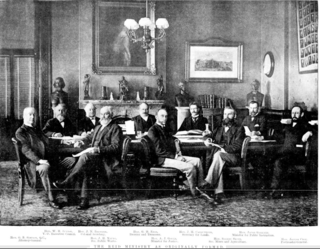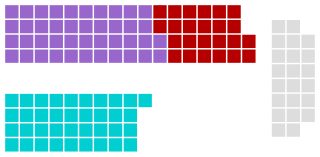Related Research Articles
Warringah was an electoral district of the Legislative Assembly in the Australian state of New South Wales and named after and including the Warringah region of the northeastern suburbs of Sydney. It was created in 1894, when multi-member districts were abolished, and the three member district of St Leonards was divided between Warringah, St Leonards and Willoughby. It was abolished in 1904 as a result of the 1903 New South Wales referendum, which required the number of members of the Legislative Assembly to be reduced from 125 to 90, and was partly replaced by Middle Harbour.

Edmund Lonsdale was an Australian politician. Born in Morpeth, New South Wales, he was schooled in Maitland before becoming a bricklayer, builder and contractor. He was also an alderman on Armidale Shire Council.

The Reid ministry was the 28th ministry of the Colony of New South Wales, and was led by the 12th Premier, George Reid. The title of Premier was widely used to refer to the Leader of Government, but was not a formal position in the government until 1920. Instead the Premier was appointed to another portfolio, usually Colonial Secretary but on this occasion Reid took the portfolio of Colonial Treasurer until July 1899 and then Attorney General.
Ellison Wentworth Quirk was a New South Wales politician, Alderman and member of the New South Wales Legislative Assembly, representing the electorate of Warringah from 1901 to 1904.

The 1901 New South Wales state election was held on 3 July 1901 for all of the 125 seats in the 19th New South Wales Legislative Assembly and it was conducted in single-member constituencies with a first past the post voting system. The Parliamentary Electorates Act of 1893 had conferred the right to vote on every male British subject over 21 years of age who was resident in New South Wales for a year or more. The 19th parliament of New South Wales was dissolved on 11 June 1901 by the Governor, Lord Beauchamp, on the advice of the Premier, John See.
There were 373 candidates contesting 125 seats at the 1901 New South Wales state election which was held on 3 July 1901.
The 1901 New South Wales state election was for 125 electoral districts, with each district returning one member. The election was conducted on the basis of a simple majority or first-past-the-post voting system. In this election, in 32 electorates the winning candidate received less than 50% of the votes, while 13 were uncontested. The average number of enrolled voters per electorate was 2,764, ranging from Wentworth (1,706) to Willoughby (4,854).
Balmain North, an electoral district of the Legislative Assembly in the Australian state of New South Wales was created in 1894 and abolished in 1904.
Boorowa, an electoral district of the Legislative Assembly in the Australian state of New South Wales was created in 1880 and abolished in 1904.
Deniliquin, an electoral district of the Legislative Assembly in the Australian state of New South Wales was created in 1894 and abolished in 1913.
Hartley, an electoral district of the Legislative Assembly in the Australian state of New South Wales had two incarnations, from 1859 until 1920 and from 1927 until 1968.
The Hastings and The Macleay, an electoral district of the Legislative Assembly in the Australian state of New South Wales was created in 1894 and abolished in 1920.
Hume, an electoral district of the Legislative Assembly in the Australian state of New South Wales was created in 1894 and abolished in 1920.
Inverell an electoral district of the Legislative Assembly in the Australian state of New South Wales was created in 1859 and abolished in 1894.
Sydney-King, an electoral district of the Legislative Assembly in the Australian state of New South Wales, was created in 1894 and abolished in 1904.
Moree, an electoral district of the Legislative Assembly in the Australian state of New South Wales was created in 1894 and abolished in 1904
St Leonards, an electoral district of the Legislative Assembly in the Australian state of New South Wales was created in 1894 and abolished in 1904.
Singleton, an electoral district of the Legislative Assembly in the Australian state of New South Wales, was created in 1894 and abolished in 1920.
Sydney-Fitzroy, an electoral district of the Legislative Assembly in the Australian state of New South Wales, was created in 1894 and abolished in 1904.
Sydney-Lang, an electoral district of the Legislative Assembly in the Australian state of New South Wales, was created in 1894 and abolished in 1904.
References
- ↑ Green, Antony. "Elections for the District of Warringah". New South Wales Election Results 1856-2007. Parliament of New South Wales . Retrieved 1 November 2020.
- ↑ Part 5B alphabetical list of all electorates and Members since 1856 (PDF). NSW Parliamentary Record. Parliament of New South Wales . Retrieved 1 November 2020.
- ↑ "Former Members". Members of Parliament. Parliament of New South Wales . Retrieved 1 November 2020.
- ↑ Green, Antony. "1901 Warringah". New South Wales Election Results 1856-2007. Parliament of New South Wales . Retrieved 1 April 2020.
- ↑ "Mr Dugald Thomson". The Australian Star . 16 July 1898. p. 9. Retrieved 1 April 2020– via Trove.
- ↑ Green, Antony. "1898 Warringah". New South Wales Election Results 1856-2007. Parliament of New South Wales . Retrieved 8 April 2020.
- ↑ Green, Antony. "1895 Warringah". New South Wales Election Results 1856-2007. Parliament of New South Wales . Retrieved 9 April 2020.
- ↑ Green, Antony. "1894 Warringah". New South Wales Election Results 1856-2007. Parliament of New South Wales . Retrieved 11 April 2020.